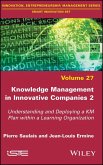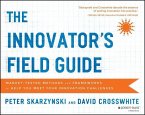139,99 €
139,99 €
inkl. MwSt.
Sofort per Download lieferbar

0 °P sammeln
139,99 €
Als Download kaufen

139,99 €
inkl. MwSt.
Sofort per Download lieferbar

0 °P sammeln
Jetzt verschenken
Alle Infos zum eBook verschenken
139,99 €
inkl. MwSt.
Sofort per Download lieferbar
Alle Infos zum eBook verschenken

0 °P sammeln
- Format: ePub
- Merkliste
- Auf die Merkliste
- Bewerten Bewerten
- Teilen
- Produkt teilen
- Produkterinnerung
- Produkterinnerung

Bitte loggen Sie sich zunächst in Ihr Kundenkonto ein oder registrieren Sie sich bei
bücher.de, um das eBook-Abo tolino select nutzen zu können.
Hier können Sie sich einloggen
Hier können Sie sich einloggen
Sie sind bereits eingeloggt. Klicken Sie auf 2. tolino select Abo, um fortzufahren.

Bitte loggen Sie sich zunächst in Ihr Kundenkonto ein oder registrieren Sie sich bei bücher.de, um das eBook-Abo tolino select nutzen zu können.
Knowledge management is a strategic issue for companies, and international standards such as ISO recently integrate it into its requirements. However, it is still an ill-defined concept, and methodologies to implement it are not very well known. This book is the result of over twenty years of research in different labs and application in a wide range of public or private companies around the world. It gives a global and coherent view both from the theoretical and practical point of views.
- Geräte: eReader
- mit Kopierschutz
- eBook Hilfe
- Größe: 4.97MB
Andere Kunden interessierten sich auch für
![Knowledge Management in Innovative Companies 2 (eBook, ePUB) Knowledge Management in Innovative Companies 2 (eBook, ePUB)]() Pierre SaulaisKnowledge Management in Innovative Companies 2 (eBook, ePUB)139,99 €
Pierre SaulaisKnowledge Management in Innovative Companies 2 (eBook, ePUB)139,99 €![Information, Knowledge and Agile Creativity (eBook, ePUB) Information, Knowledge and Agile Creativity (eBook, ePUB)]() Stephane GoriaInformation, Knowledge and Agile Creativity (eBook, ePUB)139,99 €
Stephane GoriaInformation, Knowledge and Agile Creativity (eBook, ePUB)139,99 €![The Innovative Company (eBook, ePUB) The Innovative Company (eBook, ePUB)]() Daniele ChauvelThe Innovative Company (eBook, ePUB)139,99 €
Daniele ChauvelThe Innovative Company (eBook, ePUB)139,99 €![The Gamification of Work (eBook, ePUB) The Gamification of Work (eBook, ePUB)]() Emmanuelle SavignacThe Gamification of Work (eBook, ePUB)139,99 €
Emmanuelle SavignacThe Gamification of Work (eBook, ePUB)139,99 €![The Innovator's Field Guide (eBook, ePUB) The Innovator's Field Guide (eBook, ePUB)]() Peter SkarzynskiThe Innovator's Field Guide (eBook, ePUB)27,99 €
Peter SkarzynskiThe Innovator's Field Guide (eBook, ePUB)27,99 €![Innovation in the Cultural and Creative Industries (eBook, ePUB) Innovation in the Cultural and Creative Industries (eBook, ePUB)]() Innovation in the Cultural and Creative Industries (eBook, ePUB)139,99 €
Innovation in the Cultural and Creative Industries (eBook, ePUB)139,99 €![Quantifying Human Resources (eBook, ePUB) Quantifying Human Resources (eBook, ePUB)]() Clotilde CoronQuantifying Human Resources (eBook, ePUB)139,99 €
Clotilde CoronQuantifying Human Resources (eBook, ePUB)139,99 €-
-
-
Knowledge management is a strategic issue for companies, and international standards such as ISO recently integrate it into its requirements. However, it is still an ill-defined concept, and methodologies to implement it are not very well known. This book is the result of over twenty years of research in different labs and application in a wide range of public or private companies around the world. It gives a global and coherent view both from the theoretical and practical point of views.
Dieser Download kann aus rechtlichen Gründen nur mit Rechnungsadresse in A, B, BG, CY, CZ, D, DK, EW, E, FIN, F, GR, HR, H, IRL, I, LT, L, LR, M, NL, PL, P, R, S, SLO, SK ausgeliefert werden.
Produktdetails
- Produktdetails
- Verlag: John Wiley & Sons
- Seitenzahl: 256
- Erscheinungstermin: 15. März 2018
- Englisch
- ISBN-13: 9781119516262
- Artikelnr.: 52552079
- Verlag: John Wiley & Sons
- Seitenzahl: 256
- Erscheinungstermin: 15. März 2018
- Englisch
- ISBN-13: 9781119516262
- Artikelnr.: 52552079
- Herstellerkennzeichnung Die Herstellerinformationen sind derzeit nicht verfügbar.
Jean-Louis Ermine is Head of the Department of Information Systems at INT and is also President of the French Knowledge Management Club.
Preface ix
Part 1 Theoretical Elements 1
Chapter 1 A Knowledge Value Chain 3
1.1 Introduction 3
1.2 Different KVCs 4
1.3 The DIKW model 8
1.4 KVC and management 13
1.5 Transformation processes in the KVC 15
1.6 Practical application 19
1.7 Conclusion 22
Chapter 2 The Knowledge Capital of a Company 23
2.1 Introduction 23
2.1.1 The accumulation of knowledge 23
2.1.2 The company as knowledge producer 24
2.2 Modeling a company as a knowledge producer 25
2.2.1 Systemic modeling 25
2.2.2 The "black box" model 26
2.2.3 The "division of labor" model 27
2.2.4 The informational model 27
2.2.5 The knowledge capital model 28
2.2.6 The knowledge capital and knowledge actors model 31
2.2.7 Integration of customer knowledge and external knowledge into the AIK
model 33
2.3 The operators of the AIK model 35
2.3.1 The Wenger operator 35
2.3.2 The Nonaka operators 35
2.3.3 Integration of the Nonaka theory into the AIK model 37
2.4 Tacit/explicit knowledge and knowledge communities 39
2.5 Mapping as a modeling tool to steer the AIK system 41
2.6 Practical application 43
2.7 Conclusion 45
Chapter 3 The Structure of Knowledge 47
3.1 Introduction 47
3.2 The semiotic triangle of knowledge 48
3.3 The systemic triangle of knowledge 52
3.4 The knowledge macroscope 54
3.4.1 Knowledge and information 55
3.4.2 Knowledge and meaning 56
3.4.3 Knowledge and context 57
3.5 Practical application 59
3.6 Conclusion 64
Chapter 4 Shannon's Theory of Knowledge 65
4.1 Introduction 65
4.2 Some definitions and notations 66
4.2.1 The basic unit of knowledge 66
4.2.2 Measuring knowledge 68
4.2.3 Quantity of knowledge in a corpus 69
4.3 Measurement of the quantity of information in a corpus 70
4.4 Measurement of the quantity of meaning in a corpus 75
4.4.1 Definitions and notations 75
4.4.2 Quantitative characterization of semantic graphs: Gurevich entropy 76
4.5 Measurement of usage context in a corpus 83
4.5.1 Introduction 83
4.5.2 Social networks 84
4.5.3 Hierarchical small-world networks 86
4.5.4 Scale-free networks 89
4.5.5 Quantitative characterization of the usage graph of a corpus 90
4.6 Practical application 91
4.7 Conclusion 93
Part 2 Practical Elements 97
Chapter 5 A New Approach to KM 99
5.1 Introduction 99
5.2 Two examples of KM standardization 100
5.2.1 KM and international standardization 100
5.2.2 KM in the nuclear domain 101
5.3 The French Knowledge Management Club 103
5.4 Conclusion 105
Chapter 6 A Framework for Knowledge-based KM 107
6.1 Introduction 107
6.2 The Daisy Model 108
6.3 Building a KM process framework 110
6.4 Conclusion 113
Chapter 7 KM: From Strategy to Implementation 115
7.1 Introduction 115
7.2 Framing a KM project 116
7.2.1 The objectives 116
7.2.2 Responsibilities and roles 117
7.2.3 Resources 119
7.2.4 Internal communication 119
7.2.5 Connections between KM and other company issues 119
7.2.6 Other subjects of interest to consider 121
7.3 Implementing the KM project 121
7.4 Monitoring the KM system 124
7.5 Conclusion 125
Chapter 8 Analyzing Knowledge Capital and Elaborating a KM Plan 127
8.1 Introduction 127
8.2 Tools for analyzing knowledge capital 128
8.2.1 Maps 128
8.2.2 The knowledge criticality analysis grid 129
8.3 The knowledge capital analysis process 132
8.3.1 Step 1: analyzing critical capacities 132
8.3.2 Step 2: analyzing critical knowledge 134
8.3.3 Step 3: strategic alignment 137
8.3.4 Step 4: elaborating a KM plan 139
8.4 Conclusion 142
Chapter 9 Implementing the KM Plan 143
9.1 Introduction 143
9.2 Knowledge organization 144
9.2.1 Tangible resources (explicit knowledge) 144
9.2.2 Intangible resources (tacit knowledge) 145
9.2.3 New knowledge resource additions 146
9.3 Knowledge codification 147
9.3.1 Lessons learned 148
9.3.2 Knowledge-based documents 149
9.3.3 Knowledge books 159
9.4 Knowledge sharing 179
9.4.1 Knowledge communities or communities of practice 179
9.4.2 Knowledge transfer 184
9.5 Knowledge search 193
9.5.1 Knowledge search and information retrieval 194
9.5.2 The knowledge search process 196
9.5.3 The challenge of KM in knowledge search 198
9.6 Knowledge creation 200
9.6.1 Knowledge creation and innovation 200
9.6.2 Knowledge-based innovation 202
9.6.3 Evaluating the maturity of the innovation process 207
9.7 Conclusion 209
Bibliography 211
Index 219
Part 1 Theoretical Elements 1
Chapter 1 A Knowledge Value Chain 3
1.1 Introduction 3
1.2 Different KVCs 4
1.3 The DIKW model 8
1.4 KVC and management 13
1.5 Transformation processes in the KVC 15
1.6 Practical application 19
1.7 Conclusion 22
Chapter 2 The Knowledge Capital of a Company 23
2.1 Introduction 23
2.1.1 The accumulation of knowledge 23
2.1.2 The company as knowledge producer 24
2.2 Modeling a company as a knowledge producer 25
2.2.1 Systemic modeling 25
2.2.2 The "black box" model 26
2.2.3 The "division of labor" model 27
2.2.4 The informational model 27
2.2.5 The knowledge capital model 28
2.2.6 The knowledge capital and knowledge actors model 31
2.2.7 Integration of customer knowledge and external knowledge into the AIK
model 33
2.3 The operators of the AIK model 35
2.3.1 The Wenger operator 35
2.3.2 The Nonaka operators 35
2.3.3 Integration of the Nonaka theory into the AIK model 37
2.4 Tacit/explicit knowledge and knowledge communities 39
2.5 Mapping as a modeling tool to steer the AIK system 41
2.6 Practical application 43
2.7 Conclusion 45
Chapter 3 The Structure of Knowledge 47
3.1 Introduction 47
3.2 The semiotic triangle of knowledge 48
3.3 The systemic triangle of knowledge 52
3.4 The knowledge macroscope 54
3.4.1 Knowledge and information 55
3.4.2 Knowledge and meaning 56
3.4.3 Knowledge and context 57
3.5 Practical application 59
3.6 Conclusion 64
Chapter 4 Shannon's Theory of Knowledge 65
4.1 Introduction 65
4.2 Some definitions and notations 66
4.2.1 The basic unit of knowledge 66
4.2.2 Measuring knowledge 68
4.2.3 Quantity of knowledge in a corpus 69
4.3 Measurement of the quantity of information in a corpus 70
4.4 Measurement of the quantity of meaning in a corpus 75
4.4.1 Definitions and notations 75
4.4.2 Quantitative characterization of semantic graphs: Gurevich entropy 76
4.5 Measurement of usage context in a corpus 83
4.5.1 Introduction 83
4.5.2 Social networks 84
4.5.3 Hierarchical small-world networks 86
4.5.4 Scale-free networks 89
4.5.5 Quantitative characterization of the usage graph of a corpus 90
4.6 Practical application 91
4.7 Conclusion 93
Part 2 Practical Elements 97
Chapter 5 A New Approach to KM 99
5.1 Introduction 99
5.2 Two examples of KM standardization 100
5.2.1 KM and international standardization 100
5.2.2 KM in the nuclear domain 101
5.3 The French Knowledge Management Club 103
5.4 Conclusion 105
Chapter 6 A Framework for Knowledge-based KM 107
6.1 Introduction 107
6.2 The Daisy Model 108
6.3 Building a KM process framework 110
6.4 Conclusion 113
Chapter 7 KM: From Strategy to Implementation 115
7.1 Introduction 115
7.2 Framing a KM project 116
7.2.1 The objectives 116
7.2.2 Responsibilities and roles 117
7.2.3 Resources 119
7.2.4 Internal communication 119
7.2.5 Connections between KM and other company issues 119
7.2.6 Other subjects of interest to consider 121
7.3 Implementing the KM project 121
7.4 Monitoring the KM system 124
7.5 Conclusion 125
Chapter 8 Analyzing Knowledge Capital and Elaborating a KM Plan 127
8.1 Introduction 127
8.2 Tools for analyzing knowledge capital 128
8.2.1 Maps 128
8.2.2 The knowledge criticality analysis grid 129
8.3 The knowledge capital analysis process 132
8.3.1 Step 1: analyzing critical capacities 132
8.3.2 Step 2: analyzing critical knowledge 134
8.3.3 Step 3: strategic alignment 137
8.3.4 Step 4: elaborating a KM plan 139
8.4 Conclusion 142
Chapter 9 Implementing the KM Plan 143
9.1 Introduction 143
9.2 Knowledge organization 144
9.2.1 Tangible resources (explicit knowledge) 144
9.2.2 Intangible resources (tacit knowledge) 145
9.2.3 New knowledge resource additions 146
9.3 Knowledge codification 147
9.3.1 Lessons learned 148
9.3.2 Knowledge-based documents 149
9.3.3 Knowledge books 159
9.4 Knowledge sharing 179
9.4.1 Knowledge communities or communities of practice 179
9.4.2 Knowledge transfer 184
9.5 Knowledge search 193
9.5.1 Knowledge search and information retrieval 194
9.5.2 The knowledge search process 196
9.5.3 The challenge of KM in knowledge search 198
9.6 Knowledge creation 200
9.6.1 Knowledge creation and innovation 200
9.6.2 Knowledge-based innovation 202
9.6.3 Evaluating the maturity of the innovation process 207
9.7 Conclusion 209
Bibliography 211
Index 219
Preface ix
Part 1 Theoretical Elements 1
Chapter 1 A Knowledge Value Chain 3
1.1 Introduction 3
1.2 Different KVCs 4
1.3 The DIKW model 8
1.4 KVC and management 13
1.5 Transformation processes in the KVC 15
1.6 Practical application 19
1.7 Conclusion 22
Chapter 2 The Knowledge Capital of a Company 23
2.1 Introduction 23
2.1.1 The accumulation of knowledge 23
2.1.2 The company as knowledge producer 24
2.2 Modeling a company as a knowledge producer 25
2.2.1 Systemic modeling 25
2.2.2 The "black box" model 26
2.2.3 The "division of labor" model 27
2.2.4 The informational model 27
2.2.5 The knowledge capital model 28
2.2.6 The knowledge capital and knowledge actors model 31
2.2.7 Integration of customer knowledge and external knowledge into the AIK
model 33
2.3 The operators of the AIK model 35
2.3.1 The Wenger operator 35
2.3.2 The Nonaka operators 35
2.3.3 Integration of the Nonaka theory into the AIK model 37
2.4 Tacit/explicit knowledge and knowledge communities 39
2.5 Mapping as a modeling tool to steer the AIK system 41
2.6 Practical application 43
2.7 Conclusion 45
Chapter 3 The Structure of Knowledge 47
3.1 Introduction 47
3.2 The semiotic triangle of knowledge 48
3.3 The systemic triangle of knowledge 52
3.4 The knowledge macroscope 54
3.4.1 Knowledge and information 55
3.4.2 Knowledge and meaning 56
3.4.3 Knowledge and context 57
3.5 Practical application 59
3.6 Conclusion 64
Chapter 4 Shannon's Theory of Knowledge 65
4.1 Introduction 65
4.2 Some definitions and notations 66
4.2.1 The basic unit of knowledge 66
4.2.2 Measuring knowledge 68
4.2.3 Quantity of knowledge in a corpus 69
4.3 Measurement of the quantity of information in a corpus 70
4.4 Measurement of the quantity of meaning in a corpus 75
4.4.1 Definitions and notations 75
4.4.2 Quantitative characterization of semantic graphs: Gurevich entropy 76
4.5 Measurement of usage context in a corpus 83
4.5.1 Introduction 83
4.5.2 Social networks 84
4.5.3 Hierarchical small-world networks 86
4.5.4 Scale-free networks 89
4.5.5 Quantitative characterization of the usage graph of a corpus 90
4.6 Practical application 91
4.7 Conclusion 93
Part 2 Practical Elements 97
Chapter 5 A New Approach to KM 99
5.1 Introduction 99
5.2 Two examples of KM standardization 100
5.2.1 KM and international standardization 100
5.2.2 KM in the nuclear domain 101
5.3 The French Knowledge Management Club 103
5.4 Conclusion 105
Chapter 6 A Framework for Knowledge-based KM 107
6.1 Introduction 107
6.2 The Daisy Model 108
6.3 Building a KM process framework 110
6.4 Conclusion 113
Chapter 7 KM: From Strategy to Implementation 115
7.1 Introduction 115
7.2 Framing a KM project 116
7.2.1 The objectives 116
7.2.2 Responsibilities and roles 117
7.2.3 Resources 119
7.2.4 Internal communication 119
7.2.5 Connections between KM and other company issues 119
7.2.6 Other subjects of interest to consider 121
7.3 Implementing the KM project 121
7.4 Monitoring the KM system 124
7.5 Conclusion 125
Chapter 8 Analyzing Knowledge Capital and Elaborating a KM Plan 127
8.1 Introduction 127
8.2 Tools for analyzing knowledge capital 128
8.2.1 Maps 128
8.2.2 The knowledge criticality analysis grid 129
8.3 The knowledge capital analysis process 132
8.3.1 Step 1: analyzing critical capacities 132
8.3.2 Step 2: analyzing critical knowledge 134
8.3.3 Step 3: strategic alignment 137
8.3.4 Step 4: elaborating a KM plan 139
8.4 Conclusion 142
Chapter 9 Implementing the KM Plan 143
9.1 Introduction 143
9.2 Knowledge organization 144
9.2.1 Tangible resources (explicit knowledge) 144
9.2.2 Intangible resources (tacit knowledge) 145
9.2.3 New knowledge resource additions 146
9.3 Knowledge codification 147
9.3.1 Lessons learned 148
9.3.2 Knowledge-based documents 149
9.3.3 Knowledge books 159
9.4 Knowledge sharing 179
9.4.1 Knowledge communities or communities of practice 179
9.4.2 Knowledge transfer 184
9.5 Knowledge search 193
9.5.1 Knowledge search and information retrieval 194
9.5.2 The knowledge search process 196
9.5.3 The challenge of KM in knowledge search 198
9.6 Knowledge creation 200
9.6.1 Knowledge creation and innovation 200
9.6.2 Knowledge-based innovation 202
9.6.3 Evaluating the maturity of the innovation process 207
9.7 Conclusion 209
Bibliography 211
Index 219
Part 1 Theoretical Elements 1
Chapter 1 A Knowledge Value Chain 3
1.1 Introduction 3
1.2 Different KVCs 4
1.3 The DIKW model 8
1.4 KVC and management 13
1.5 Transformation processes in the KVC 15
1.6 Practical application 19
1.7 Conclusion 22
Chapter 2 The Knowledge Capital of a Company 23
2.1 Introduction 23
2.1.1 The accumulation of knowledge 23
2.1.2 The company as knowledge producer 24
2.2 Modeling a company as a knowledge producer 25
2.2.1 Systemic modeling 25
2.2.2 The "black box" model 26
2.2.3 The "division of labor" model 27
2.2.4 The informational model 27
2.2.5 The knowledge capital model 28
2.2.6 The knowledge capital and knowledge actors model 31
2.2.7 Integration of customer knowledge and external knowledge into the AIK
model 33
2.3 The operators of the AIK model 35
2.3.1 The Wenger operator 35
2.3.2 The Nonaka operators 35
2.3.3 Integration of the Nonaka theory into the AIK model 37
2.4 Tacit/explicit knowledge and knowledge communities 39
2.5 Mapping as a modeling tool to steer the AIK system 41
2.6 Practical application 43
2.7 Conclusion 45
Chapter 3 The Structure of Knowledge 47
3.1 Introduction 47
3.2 The semiotic triangle of knowledge 48
3.3 The systemic triangle of knowledge 52
3.4 The knowledge macroscope 54
3.4.1 Knowledge and information 55
3.4.2 Knowledge and meaning 56
3.4.3 Knowledge and context 57
3.5 Practical application 59
3.6 Conclusion 64
Chapter 4 Shannon's Theory of Knowledge 65
4.1 Introduction 65
4.2 Some definitions and notations 66
4.2.1 The basic unit of knowledge 66
4.2.2 Measuring knowledge 68
4.2.3 Quantity of knowledge in a corpus 69
4.3 Measurement of the quantity of information in a corpus 70
4.4 Measurement of the quantity of meaning in a corpus 75
4.4.1 Definitions and notations 75
4.4.2 Quantitative characterization of semantic graphs: Gurevich entropy 76
4.5 Measurement of usage context in a corpus 83
4.5.1 Introduction 83
4.5.2 Social networks 84
4.5.3 Hierarchical small-world networks 86
4.5.4 Scale-free networks 89
4.5.5 Quantitative characterization of the usage graph of a corpus 90
4.6 Practical application 91
4.7 Conclusion 93
Part 2 Practical Elements 97
Chapter 5 A New Approach to KM 99
5.1 Introduction 99
5.2 Two examples of KM standardization 100
5.2.1 KM and international standardization 100
5.2.2 KM in the nuclear domain 101
5.3 The French Knowledge Management Club 103
5.4 Conclusion 105
Chapter 6 A Framework for Knowledge-based KM 107
6.1 Introduction 107
6.2 The Daisy Model 108
6.3 Building a KM process framework 110
6.4 Conclusion 113
Chapter 7 KM: From Strategy to Implementation 115
7.1 Introduction 115
7.2 Framing a KM project 116
7.2.1 The objectives 116
7.2.2 Responsibilities and roles 117
7.2.3 Resources 119
7.2.4 Internal communication 119
7.2.5 Connections between KM and other company issues 119
7.2.6 Other subjects of interest to consider 121
7.3 Implementing the KM project 121
7.4 Monitoring the KM system 124
7.5 Conclusion 125
Chapter 8 Analyzing Knowledge Capital and Elaborating a KM Plan 127
8.1 Introduction 127
8.2 Tools for analyzing knowledge capital 128
8.2.1 Maps 128
8.2.2 The knowledge criticality analysis grid 129
8.3 The knowledge capital analysis process 132
8.3.1 Step 1: analyzing critical capacities 132
8.3.2 Step 2: analyzing critical knowledge 134
8.3.3 Step 3: strategic alignment 137
8.3.4 Step 4: elaborating a KM plan 139
8.4 Conclusion 142
Chapter 9 Implementing the KM Plan 143
9.1 Introduction 143
9.2 Knowledge organization 144
9.2.1 Tangible resources (explicit knowledge) 144
9.2.2 Intangible resources (tacit knowledge) 145
9.2.3 New knowledge resource additions 146
9.3 Knowledge codification 147
9.3.1 Lessons learned 148
9.3.2 Knowledge-based documents 149
9.3.3 Knowledge books 159
9.4 Knowledge sharing 179
9.4.1 Knowledge communities or communities of practice 179
9.4.2 Knowledge transfer 184
9.5 Knowledge search 193
9.5.1 Knowledge search and information retrieval 194
9.5.2 The knowledge search process 196
9.5.3 The challenge of KM in knowledge search 198
9.6 Knowledge creation 200
9.6.1 Knowledge creation and innovation 200
9.6.2 Knowledge-based innovation 202
9.6.3 Evaluating the maturity of the innovation process 207
9.7 Conclusion 209
Bibliography 211
Index 219







